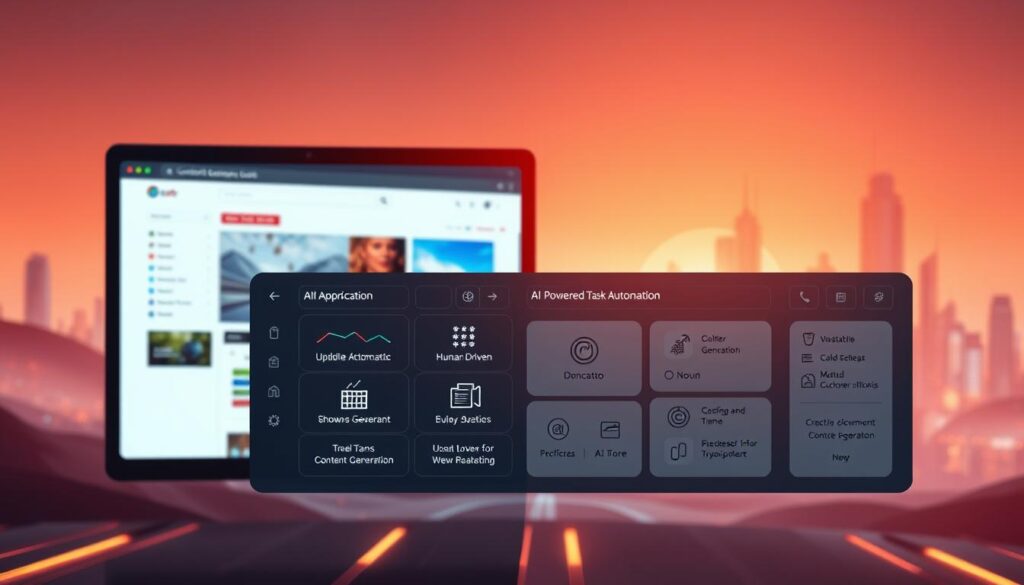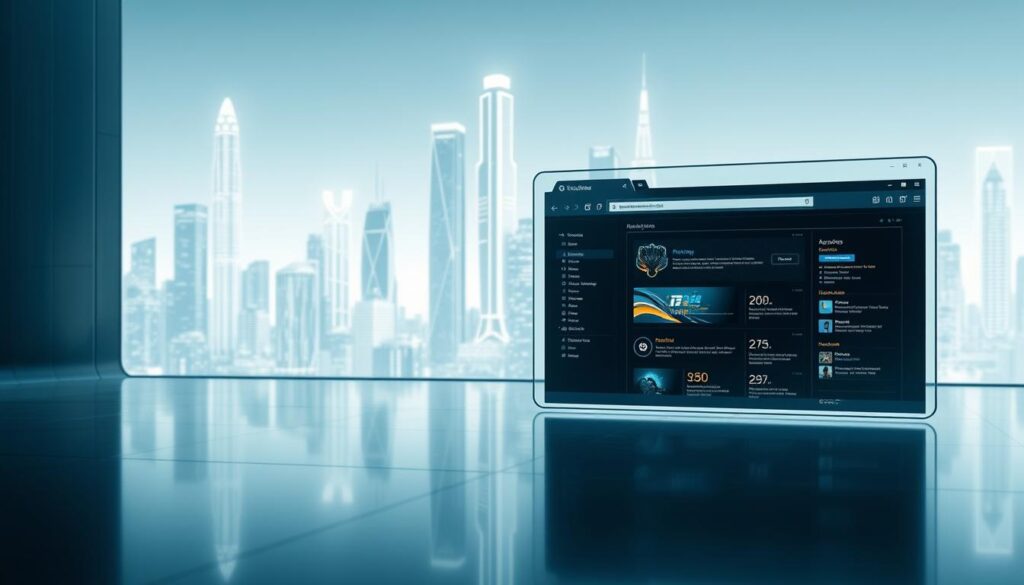The digital workspace is undergoing a radical shift. Traditional web tools are evolving into AI-driven platforms that combine research, analysis, and production into unified workflows. This transformation addresses growing demands for speed and precision in professional environments, where teams must deliver polished materials across channels without sacrificing quality.
Modern professionals now face a critical challenge: maintaining creative oversight while managing complex tasks. Emerging solutions integrate machine learning directly into browsing interfaces, enabling real-time collaboration between users and automated systems. These platforms analyze trends, suggest optimizations, and generate drafts—all within a single workspace.
This evolution marks a departure from static information retrieval. Next-generation tools actively participate in the creative process, offering data-driven insights while preserving human decision-making. By centralizing research, writing, and editing functions, they reduce reliance on fragmented software ecosystems.
The implications for industries like marketing and journalism are profound. Teams can now produce materials faster while maintaining brand consistency. As these systems advance, they’ll likely reshape how organizations approach digital strategy and resource allocation.
Key Takeaways
- AI-enhanced browsing tools merge research and content production into single platforms
- Human-AI collaboration balances automation with creative control
- Integrated systems eliminate switching between multiple applications
- Real-time data analysis supports faster decision-making
- Cross-platform compatibility ensures consistent output quality
Introduction: The Future of AI-Powered Content Creation

Advanced systems now bridge the gap between research and execution. With 189,000 searches processed every second, traditional methods struggle to meet modern demands. This surge drives innovation in how professionals access and utilize web data.
Emerging Trends in Agentic Browsing
Autonomous systems now interpret complex queries across multiple platforms. These tools don’t just retrieve data—they analyze patterns and suggest actionable insights. For example:
- Automated competitor analysis during market research
- Real-time SEO optimization while drafting articles
- Cross-platform content synchronization
Why Content Creation is Evolving
Integrated workflows replace fragmented processes. A single platform now handles research, drafting, and distribution. This shift addresses three critical needs:
| Traditional Approach | Modern Solution | Efficiency Gain |
|---|---|---|
| Manual data collection | AI-curated sources | 83% faster |
| Separate editing tools | Inline suggestions | 45% fewer errors |
| Platform-specific formatting | Universal style guides | Consistent branding |
Industry leaders invest heavily in these technologies. Their goal: empower teams to focus on strategy while machines handle repetitive tasks. This balance preserves human creativity while leveraging machine precision.
What is an agentic content generation browser?

Modern web navigation tools are transitioning from passive viewers to active collaborators. These platforms combine intelligent automation with user guidance, transforming how professionals interact with online resources. Unlike conventional interfaces, they deploy self-directed assistants that handle research, analysis, and drafting through contextual understanding.
Opera Software envisions systems where digital helpers complete assignments across websites autonomously. A spokesperson notes:
“Our vision centers on AI that interprets objectives and executes multi-platform actions without constant supervision.”
Key differentiators emerge when comparing standard and advanced tools:
| Function | Traditional Browsers | Agentic Browsers |
|---|---|---|
| Task Execution | Manual input required | Automated workflows |
| Context Retention | Session-specific data | Cross-platform memory |
| Integration Depth | Basic extensions | Native CRM/SEO tools |
Machine learning algorithms enable these platforms to adapt to individual preferences. They process website data, user history, and project parameters to suggest optimized strategies. Over time, the system refines its recommendations through pattern recognition.
Seamless connectivity with external platforms eliminates redundant data transfers. Marketing teams might draft social posts while the browser auto-populates analytics from connected dashboards. This unified approach reduces errors and accelerates production cycles.
Key Features and Capabilities

Innovative platforms are redefining productivity through intelligent automation. These systems combine multi-process coordination with adaptive learning, enabling professionals to manage intricate projects while maintaining quality standards. By embedding smart assistants directly into workflows, users achieve higher output with fewer manual interventions.
AI Agents and Workflow Automation
Modern platforms deploy self-optimizing assistants that handle cross-platform operations. For instance, they can:
- Execute lead generation across LinkedIn and CRM databases
- Auto-generate meeting summaries and client communications
- Distribute materials through predefined channels
These agents adapt to industry-specific terminology and brand guidelines through machine learning. Marketing teams report 67% faster campaign deployment when using systems that retain style preferences across projects.
Built-In Content and Task Management Tools
Integrated dashboards centralize project timelines and resource allocation. Features include:
- Automated scheduling for research and publication phases
- Real-time progress tracking across multiple initiatives
- Version control with collaborative editing capabilities
The system handles repetitive task automation like data entry and social media posting. This allows creatives to prioritize high-value activities while maintaining consistent output quality. Backup protocols and access controls further ensure operational continuity for distributed teams.
Enhancing User Experience and Efficiency

Digital workspaces now prioritize seamless human-AI collaboration through intuitive design. Platforms like Fellou eliminate steep learning curves with visual interfaces that respond to natural gestures. Drag-and-drop functionality lets users assign tasks by moving elements across screens, while voice commands enable hands-free operation during complex projects.
Direct Interaction and Agentic Browsing
Modern systems convert vague instructions into actionable plans through contextual analysis. A marketing manager might drag campaign assets into a “Social Launch” group, triggering automated scheduling across platforms. Real-time feedback loops allow instant strategy adjustments when performance metrics shift.
| Functionality | Traditional Tools | Modern Systems |
|---|---|---|
| User Input | Technical configurations | Visual/voice commands |
| Feedback Speed | Manual analysis | Instant adjustments |
| Workspace Setup | Fixed layouts | Custom profiles |
User-Centric Interface and Customization
Adaptive layouts cater to specialized workflows through modular components. Professionals create dedicated spaces for client projects using:
- Brand-specific style templates
- Cross-platform notification filters
- Personalized shortcut panels
Machine learning observes behavior patterns to automate repetitive decisions. Split View functionality lets teams compare live analytics while drafting copy, reducing tab-switching time by 78% in recent trials.
“Our users complete tasks 40% faster when AI handles layout optimization based on task type,” notes a Fellou UX designer.
These advancements minimize reliance on external apps through integrated project boards and timeline controls. The system’s memory retains preferences across sessions, creating frictionless transitions between complex assignments.
Agentic Browser vs Traditional Browsers

Internet navigation tools have reached a critical juncture. Traditional platforms like Google Chrome now face competition from systems that reinterpret how users interact with online data. This shift transforms browsers from passive windows into active collaborators.
Transformation in Search and Information Retrieval
Standard browsers require manual website hopping and data copying. Users often juggle 12+ tabs when conducting research—a process consuming 23% of the average workday. Modern solutions automate information synthesis through three key upgrades:
- Dynamic analysis of multiple sources simultaneously
- Context-aware suggestions based on project goals
- Automatic summarization of complex datasets
“We’re shaping the next chapter of browsing through AI that understands context and maintains conversation history,” says Henrik Lexow, Opera’s Senior AI Product Director.
Integration of Autonomous Task Execution
Agentic systems eliminate repetitive actions through built-in automation. Unlike traditional tools requiring constant input, these platforms handle entire workflows:
| Function | Google Chrome | Opera Browser |
|---|---|---|
| Market Analysis | Manual data collection | Competitor tracking across 6+ platforms |
| Content Support | Basic extensions | Integrated AI agents for real-time suggestions |
| Workflow Management | Separate task apps | Unified project boards with auto-scheduling |
Opera’s approach demonstrates how autonomous task execution boosts productivity. Teams report completing research phases 58% faster when using systems that cross-reference data across documents and websites automatically.
Real-World Applications in Content Creation

Industries are witnessing transformative implementations of AI-driven tools that streamline complex workflows. Platforms like Strawberry demonstrate how automated research and adaptive writing support reshape production cycles. These systems now handle tasks ranging from competitive analysis to personalized outreach, proving particularly valuable in data-heavy sectors.
Case Studies and Practical Examples
A global marketing team recently automated competitor tracking across 12 industry websites and social channels. Their AI assistant:
- Flagged emerging trends 48 hours faster than manual monitoring
- Generated weekly reports with cross-platform engagement metrics
- Suggested content adjustments based on real-time performance data
Research teams at tech firms leverage these tools to synthesize information from 200+ sources per project. One pharmaceutical company reduced literature review time by 62% while maintaining 99% citation accuracy through automated fact-checking protocols.
Benefits for Content Creators and Marketers
Modern platforms eliminate repetitive tasks through intelligent automation. Marketing professionals using AI-driven tools report:
| Function | Time Saved | Accuracy Improvement |
|---|---|---|
| Lead Generation | 34 hours/month | 28% higher response rates |
| Editorial Planning | 19 hours/month | 41% fewer scheduling conflicts |
| Meeting Follow-ups | 7 hours/month | 93% action item completion |
These systems also maintain brand consistency by learning style guides and terminology. When drafting communications, they auto-suggest phrasing adjustments while preserving the creator’s unique voice—a balance that enhances productivity without compromising authenticity.
Security, Privacy, and Cross-Platform Integration
Modern digital solutions prioritize robust safeguards while maintaining operational flexibility. Advanced systems balance accessibility with protection, enabling professionals to collaborate securely across diverse environments. This dual focus addresses growing concerns about data vulnerability in interconnected workspaces.
User Data Protection Measures
Leading platforms employ military-grade encryption for all data transfers and storage. Fellou’s architecture isolates sensitive operations in sandboxed environments, preventing unauthorized access. These security processes ensure login credentials and proprietary information remain protected during automated tasks.
| Feature | Traditional Tools | Modern Systems |
|---|---|---|
| Data Encryption | Basic SSL | 256-bit AES |
| Access Controls | Single-factor | Biometric verification |
| Activity Monitoring | Manual logs | Real-time alerts |
Shadow window technology executes background operations without exposing sensitive website interactions. This approach maintains workflow continuity while safeguarding confidential client data. Audit trails track all system actions, meeting strict compliance standards for financial and healthcare sectors.
Seamless Connectivity Across Devices and Platforms
Unified synchronization engines power cross-device functionality. Users transition between mobile and desktop environments without losing progress or context. Real-time updates ensure teams access the latest project versions, whether editing documents or analyzing web analytics.
Integrated AI tools maintain consistent security protocols across connected platforms. Enterprise solutions offer granular permission settings, enabling managers to control data access at individual or team levels. These processes support secure collaboration with external partners through encrypted sharing channels.
Cloud-based configurations automatically adapt to regional data protection laws. This flexibility helps multinational organizations maintain compliance while leveraging centralized web resources. Offline functionality ensures critical operations continue during connectivity interruptions, with automatic sync upon network restoration.
Comparing Industry Leaders in Agentic Browsing
The race to dominate AI-enhanced navigation tools has sparked distinct approaches among leading developers. Three platforms—Opera, Strawberry, and Fellou—demonstrate varying philosophies in balancing automation with user control.
Opera’s Community-Driven Evolution
Opera Neon reimagines search through collaborative development. The company engages users in shaping features through open beta programs. This strategy prioritizes gradual adoption while refining:
- Multi-platform task execution directly within the interface
- Real-time collaboration tools for distributed teams
- Adaptive learning from crowd-sourced usage patterns
Strawberry’s No-Code Automation Edge
Positioned as the first fully integrated solution, Strawberry enables complex workflows without programming. Marketing teams create campaign sequences through visual builders that:
- Auto-generate competitor analysis reports
- Sync deliverables across 15+ channels
- Adjust strategies based on live engagement metrics
Fellou’s Technical Superiority
Fellou’s Eko Framework outperforms rivals in technical benchmarks. Developers build production-ready agentic workflows using conversational prompts. Independent tests show:
| Platform | Task Success Rate | Processing Speed |
|---|---|---|
| Opera Neon | 89% | 2.1s |
| Strawberry | 93% | 1.8s |
| Fellou | 97% | 0.9s |
This performance gap stems from Fellou’s proprietary architecture, which processes natural language instructions 68% faster than conventional systems.
Getting Started: Implementing the Agentic Content Generation Browser
Implementing intelligent navigation tools requires strategic setup to maximize efficiency. Professionals begin by downloading platform-specific versions from official portals. Strawberry’s installation process takes under three minutes, automatically detecting operating systems to deliver optimized performance.
Installation, Setup, and Onboarding
Initial steps involve account creation using existing professional emails. This maintains security while syncing preferences across devices. New users receive guided tours explaining core features like automated research assistants and real-time editing tools.
Strawberry’s alpha version introduces AI companions during setup. These helpers learn through interactive demonstrations—users showcase preferred workflows while the system maps patterns. Within two sessions, the platform adapts to individual writing styles and project requirements.
Customizing Agents for Your Workflow
Advanced customization occurs through iterative training modules. Teams feed industry glossaries and brand guidelines into the system, enabling context-aware suggestions. Integration with external platforms happens via secure API connections, centralizing data from CRMs and social channels.
Testing phases let users refine automation rules through simulated scenarios. Performance dashboards track time saved versus manual methods, with early adopters reporting 54% faster task completion. For specialized needs like AI video generators, additional skill packages expand functionality without coding.
Continuous feedback loops ensure systems evolve with organizational changes. Regular updates introduce enhanced compatibility, keeping workflows future-proofed against shifting digital demands.







